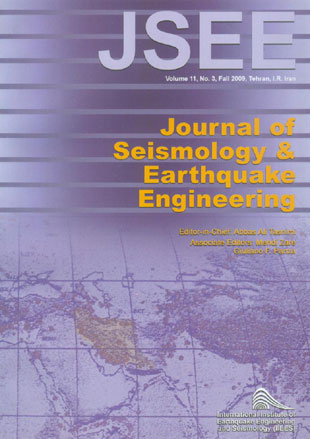فهرست مطالب

Journal of Seismology and Earthquake Engineering
Volume:11 Issue: 3, Autumn 2009
- تاریخ انتشار: 1388/08/11
- تعداد عناوین: 5
-
-
Page 111In this paper an approach is presented to predict the concentration and the trend of aftershocks of May 12 2008 Chengdu, Sichuan, China earthquake. The method is based on inputting first aftershocks to Kohonen artificial neural network. Artificial neural networks, which are inspired from human brain, consist of several artificial neurons which are connected with some weight vectors to each other. Artificial neural networks are able to classify a large volume of input data (i.e. earthquake catalogue) simultaneously and in parallel, and can recognize seismic patterns very well. Kohonen neural networks consist of several neurons that affect mutually on each other to display important statistical characteristics of the input space (i.e. first aftershocks). Combination of associative and competitive learning rules results in formation of Kohonen''s self-organizing feature map (SOFM) algorithm. SOFM algorithm has converged; the feature map computed by the SOFM algorithm indicates the concentration and the trend of aftershocks precisely. Kohonen artificial neural networks have become powerful intelligent tools in recent years, used widely in pattern recognition and data clustering.
-
Page 121In this paper, the strong motion accelerograms of October 17, 2009, Tehran-Ray earthquake (MW=4.0) of south of Tehran were analyzed. (i) Using derived SH-wave spectral data, at first the parameters Ωo (long period spectral level), ∫c (corner frequency) and Q(f) (frequency dependent, average shear wave quality factor), appropriate for the best-fit Brune ω-2 spectrum of this event were estimated. Then a non-linear least square analysis of the SH-wave spectral data was performed to provide objectively approximate near field estimates of the strike, dip and rake of the causative fault. Based on this analysis, the first fault plane solution has been presented for this event, which may be related to Eyvanaki fault closed to Tehran. Near field estimates of the strike, dip and rake of the causative fault of the 2009 Ray-Tehran earthquake are 292o, 36o, and 59o, respectively. Our estimated fault plane solutions suggest a reverse faulting mechanism with minor left lateral strike slip component. The estimated strike is consistent with the direction of isoacceleration map and Eyvanaki fault.
-
Page 133The most important parameters in evaluation of dynamic behavior of soil structures such as highways, retaining walls, and embankments are shear modulus and damping ratio. A fiber reinforced soil behaves as a composite material in which fibers of relatively high tensile strength are embedded in a matrix of soil. Shear stresses in the soil mobilize tensile resistance in the fibers, which in turn imparts greater strength to the soil. This study deals with assessment of fine sand reinforced with carpet and geotextile strips when subjected to dynamic loading by performing two sets of cyclic triaxial test- large scale and small scale. In these tests the influences of various parameters such as confining pressure, mixture ratio, and the ratio of strip length to its thickness which will herein be referred to as aspect ratio on the dynamic behavior of reinforced fine sand were studied. The results demonstrate that the effects of this kind of reinforcement on shear modulus in low confining pressures (less than 100kPa) are negligible and in high confining pressures are considerable.
-
Page 143Nonlinear numerical analyses have been performed for the highest dam with asphalt concrete core in Iran (Shur River Dam) under seismic forces. The dam has 85 meters height and is under construction in an area with high earthquake hazard with MDE equal to 0.8g. Different stages of construction and impounding were analyzed using the hyperbolic model with Finite Difference Method. Nonlinear dynamic analyses were performed to investigate asphaltic core behavior under earthquake loading. The results show that earthquake shock can lead to developing some small cracks and increasing permeability of asphalt in the upper part of the core. Maximum vertical deformations occur near the crest and at the lower part of the upstream slope but would not be sufficient to cause loss of storage under normal operating conditions. Also deformation of asphalt core is completely dependent on the shell deformation and the thin wall core can not affect the general behavior of the dam. During the dynamic loading, different displacements between the thin core and transition layers are observed.
-
Page 153Reservoir-triggered seismicity (RTS) is a phenomenon, which has been observed in several large dam projects all over the world, especially for the reservoirs which are constructed in seismically active regions. Practically all the territory of the Republic of Armenia is characterized as the high seismic active area. A review of reservoir triggered seismicity in Armenia shows that it mainly occurs in large dams which are located near active faults. In this paper it has been shown that the number of microearthquakes increase after Tolors reservoir operation, cause changes of seismic regime in the observed regions. The correlation of seismicity and water level in Tolors reservoir allows assuming the influence of long-term harmonious changes of water level on the seismic activity in the region.


